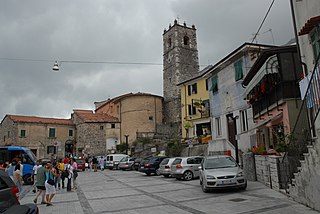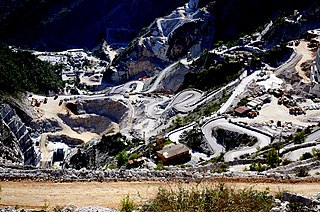
Carrara is a city and comune in Tuscany, in central Italy, of the province of Massa and Carrara, and notable for the white or blue-grey marble quarried there. It is on the Carrione River, some 100 kilometres (62 mi) west-northwest of Florence. Its motto is Fortitudo mea in rota.

Carrara marble, Luna marble to the Romans, is a type of white or blue-grey marble popular for use in sculpture and building decor. It has been quarried since Roman times in the mountains just outside the city of Carrara in the province of Massa and Carrara in the Lunigiana, the northernmost tip of modern-day Tuscany, Italy.

The Lunigiana is a historical territory of Italy, which today falls within the provinces of Massa Carrara, Tuscany, and La Spezia, Liguria. Its borders derive from the ancient Roman settlement, later the medieval diocese of Luni, which no longer exists.

The Duchy of Massa and Principality of Carrara was a small state that controlled the towns of Massa and Carrara; the area is now part of unified Italy, but retains its local identity as the province of Massa-Carrara.

Massa is a town and comune in Tuscany, central Italy, the administrative centre of the province of Massa and Carrara. It is located in the Frigido River Valley, near the Alpi Apuane, 5 km (3 mi) from the Tyrrhenian Sea.

Luni is a comune (municipality) in the province of La Spezia, in the easternmost end of the Liguria region of northern Italy. It was founded by the Romans as Luna. It gives its name to Lunigiana, a region spanning eastern Liguria and northern Tuscany.
The Orto Botanico dei Frignoli is a botanical garden located at 900 metres elevation on SS63 del Passo del Cerreto, Fivizzano, Province of Massa-Carrara, Italy. It is open daily in the warmer months; an admission fee is charged.

Carrara Cathedral is a Roman Catholic church, dedicated to Saint Andrew, in the town of Carrara, located in central Italy. Most of the exterior, and much of the interior, is covered in the local Carrara marble.

The Frigido is a short river in Tuscany, central Italy, whose course of 17 km is entirely included in the province of Massa-Carrara. It starts from two branches, one having its source in the Monte Sagro and Monte Rasore, the other near the village of Forno.

The Genoa–Pisa railway is one of the trunk lines of the Italian railway network. It runs along the Ligurian coast from Genoa to Pisa through the Riviera di Levante and the Versilia. It passes through the cities of Massa, Carrara and La Spezia. South of Pisa the Pisa–Rome line continues along the Tyrrhenian coast to Rome. The line is double track and is fully electrified at 3,000 V DC. Passenger traffic is managed by Trenitalia.

Colonnata is an Italian ancient village and a hamlet (frazione) of the comune of Carrara,. It is situated in the Apuan Alps, and is known worldwide for the pork fat delicacy Lardo di Colonnata, and for its marble quarries.

The Lunigiana revolt took place in January 1894, in the stone and marble quarries of Massa and Carrara in the Lunigiana, the northernmost tip of Tuscany (Italy), in support of the Fasci Siciliani uprising on Sicily. After a state of siege had been proclaimed by the Crispi government, armed bands dispersed into the mountains pursued by troops. Hundreds of insurgents were arrested and tried by military tribunals.

Retignano is a village of about 400 inhabitants, located on a hill in the historical Versilia, a northern area of the Italian region of Tuscany, in the municipality of Stazzema, about 430 meters above sea level. The inhabitants are called Retignanesi.

The Marmifera, full name Italian: Ferrovia Marmifera Privata di Carrara, lit. 'private marble railway of Carrara', was an Italian industrial railway used for the transport of Carrara marble from the quarries of the municipal territory of Carrara, Tuscany. The route extended from the hillside village of Colonnata to the port of Marina di Carrara.

The Avenza–Carrara railway was a short line connecting the center of Carrara with the locality of Avenza, falling in the same municipality, on which there was and still there is a station of the Genoa-Pisa railway. Opened in 1866, the line constituted later an element of the Carrara Private Marble railway; after the closure of the latter it remained in service as goods connection until the closure to traffic in 1969. The definitive suppression was established by Decree of the President of the Republic no. 1459 of December 28, 1970.

Rock shelter of the Equi Spa is located on the northern fringe of the Apuan Alps, not far from the famous Carrara marble quarries in northern Italy. The Rock shelter is located by a small the small hamlet of Equi Terme which is a currently developing tourist attraction with three selling points, an archaeological site, a natural cave system and a hiking trail along the northern fringe of the Apuan Alps.

Miseglia is a village in Tuscany, central Italy, administratively a frazione of the comune of Carrara, province of Massa-Carrara. At the time of the 2011 census its population amounted to 449.

Montalto is a mountain located in Tuscany, Italy and part of the Apuan Alps range. Its highest peak is at roughly 913 meters above the sea level and it is also home of two villages, Retignano and Volegno, in the municipality of Stazzema, Province of Lucca.

No Cav is a journalistic term used to indicate a large Italian protest movement that arose in the early years of the 21st century composed of associations and groups of citizens united by the criticism of the Carrara marble quarries in the Apuan Alps.






















